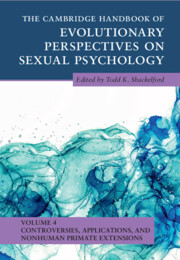Book contents
- The Cambridge Handbook of Evolutionary Perspectives on Sexual Psychology
- The Cambridge Handbook of Evolutionary Perspectives on Sexual Psychology
- Copyright page
- Contents
- Contributors
- Preface
- Part I Controversies and Unresolved Issues
- Part II Applications to Health, Law, and Pornography
- 6 Male Reproductive Health
- 7 Women’s Menstrual Cycles and Ovulation Provide Balanced Estradiol and Progesterone for Fertility and Lifelong Health
- 8 Female Genital Cutting
- 9 Costs of Polygyny
- 10 Male Sexual Disorders
- 11 An Evolutionary Perspective on Female Sexual Concerns and Dysfunctions
- 12 Evolutionary Perspectives on Male Sexual Offending
- 13 Pornography and Male Sexual Psychology
- Part III Nonhuman Primate Sexual Behavior
- Index
- References
8 - Female Genital Cutting
from Part II - Applications to Health, Law, and Pornography
Published online by Cambridge University Press: 30 June 2022
- The Cambridge Handbook of Evolutionary Perspectives on Sexual Psychology
- The Cambridge Handbook of Evolutionary Perspectives on Sexual Psychology
- Copyright page
- Contents
- Contributors
- Preface
- Part I Controversies and Unresolved Issues
- Part II Applications to Health, Law, and Pornography
- 6 Male Reproductive Health
- 7 Women’s Menstrual Cycles and Ovulation Provide Balanced Estradiol and Progesterone for Fertility and Lifelong Health
- 8 Female Genital Cutting
- 9 Costs of Polygyny
- 10 Male Sexual Disorders
- 11 An Evolutionary Perspective on Female Sexual Concerns and Dysfunctions
- 12 Evolutionary Perspectives on Male Sexual Offending
- 13 Pornography and Male Sexual Psychology
- Part III Nonhuman Primate Sexual Behavior
- Index
- References
Summary
The global impact of female genital cutting (FGC) is considerable, with an estimated 200 to 300 million women alive today who have undergone some form of FGC and a further 3 million girls at risk of being cut every year. The immediate and long-term negative health consequences for girls and women are well documented, yet this behavior is under parental control. The reasons why this behavior persists despite its potential detrimental impact on both health and evolutionary fitness is of interest to both evolutionary scientists and policy makers. Despite intense research and programme activity, implementing behavioral change has proved challenging. This chapter starts with an overview of FGC, focusing on the 29 countries in Africa and Asia where FGC is most prevalent. This illustrates the extensive variation in FGC in terms of prevalence, geographical distribution, procedure and practice, consequences to health and well-being, and resistance to intervention. This context allows the more pertinent question of why FGC persists to be explored. However, the variety of FGC forms and contexts in which FGC is practiced suggest that generalized explanations for its persistence should be made with caution. The local beliefs sustaining the practice and the more prominent social theories are described, followed by an examination of the ways in which evolutionary perspectives can be applied to understand the persistence of FGC. Evolutionary theory is uniquely placed to address the question of why FGC persists, as ultimate explanations of behavior are concerned with fitness consequences rather than the impact on health or well-being. Three different ways in which evolutionary theory has been applied to FGC are considered. First, the prediction that FGC persists because it enhances reproductive success is examined. Findings show that women who conform to the FGC norm within their community have higher reproductive success. This gives some indication about the contexts in which deciding to have a daughter undergo FGC might be adaptive in fitness terms leading to enhanced inclusive fitness for the parents. Second, the prediction that paternity concern is a driver for FGC is examined. Despite widespread beliefs to the contrary, FGC is not shown to affect women’s sexual activity. However, concern about paternity may still affect marriage choices for men, and thus influence parental FGC behavior. Finally, the prediction that FGC is a signal of genetic quality to potential marriage partners is reviewed, concluding that FGC does not meet the criteria of costly signaling. In contrast to the attention that FGC has received from many other disciplines, there are relatively few studies that have addressed FGC using evolutionary theory. However, this chapter demonstrates the great potential for furthering our understanding of FGC behavior by applying evolutionary theory, and working with policy makers to effect change.
Keywords
- Type
- Chapter
- Information
- Publisher: Cambridge University PressPrint publication year: 2022



